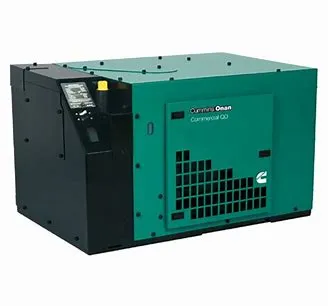Powering Reliability: The Caterpillar Gas Generator G3516

In the demanding world of industrial operations, consistent and reliable power is not just a convenience; it's an absolute necessity. Interruptions can lead to significant financial losses, impact production schedules, and even compromise safety. This is where the role of a robust, high-performance generator becomes critical. While many options exist in the market, certain machines stand out due to their proven track record, engineering excellence, and ability to perform under challenging conditions. Among these, the Caterpillar gas generator G3516 has earned a reputation as a cornerstone of reliable power generation in numerous applications globally. Designed to operate efficiently on a variety of gaseous fuels, this particular model embodies Caterpillar's commitment to durability and performance, making it a go-to solution for facilities that require dependable power sources, whether for continuous operation, prime power, or even combined heat and power (CHP) systems. Understanding the capabilities and advantages of this specific generator is key for any operation looking to secure its energy future and optimize its operational efficiency.
The Core Role and Versatility of the Cat G3516
The Caterpillar gas generator G3516 is engineered for a wide range of power generation tasks, extending far beyond simple backup power. Its design makes it exceptionally well-suited for scenarios where reliable, non-stop electricity is essential. Think about manufacturing plants, wastewater treatment facilities utilizing biogas, or oil and gas operations needing continuous power in remote locations. The G3516 can seamlessly integrate into these complex systems, providing stable power output that meets stringent grid requirements or supports isolated loads effectively. Interestingly enough, its versatility in handling different gaseous fuels—including natural gas, biogas, and even propane—significantly broadens its potential applications. This fuel flexibility is a major advantage, allowing businesses to potentially leverage locally available or cost-effective fuel sources, contributing to lower operating expenses and greater energy independence. Have you ever considered how harnessing a readily available waste product, like biogas from anaerobic digestion, could not only solve disposal issues but also power your entire operation? The G3516 makes this a tangible reality for many industries, demonstrating its adaptability and forward-thinking design.
Powering Diverse Applications with Gaseous Fuels
Expanding on its fuel flexibility, the Caterpillar G3516 generator is a champion in diverse power generation scenarios. For facilities with access to pipeline natural gas, the G3516 offers a highly efficient and relatively clean burning option for continuous power needs. However, its ability to run on alternative fuels like biogas is where its true environmental and economic value often shines. Industries such as agriculture (dairy farms), food processing, and municipal wastewater treatment plants produce significant amounts of organic waste. Anaerobic digestion of this waste yields biogas, a renewable fuel source primarily composed of methane. The G3516 is specifically designed to handle the variations in composition and quality often found in biogas, turning a potential waste disposal problem into a valuable energy asset. This capability supports sustainability goals while providing reliable power. Furthermore, in regions where natural gas infrastructure is limited, the G3516 can be configured to run on other gaseous fuels, offering crucial flexibility for off-grid or remote operations. This adaptability ensures that the G3516 isn't just a power generator but a strategic energy solution tailored to specific site conditions and fuel availability.
Key Engineering Features of the Caterpillar G3516
What sets the Caterpillar gas generator G3516 apart are the underlying engineering principles and features designed for maximum durability and operational efficiency. At its heart is the robust Cat G3516 engine, renowned for its industrial-grade construction built to withstand continuous duty cycles and heavy loads. The engine incorporates advanced combustion technology optimized for gaseous fuels, ensuring clean and efficient energy conversion. This includes features like advanced ignition systems and precise air-fuel ratio controls, which are critical for stable operation and meeting emissions standards. The integrated control system, often a Cat ADEM™ system, provides sophisticated monitoring, diagnostics, and control capabilities, allowing operators to optimize performance and troubleshoot issues effectively. Frankly speaking, the level of control and data feedback available on modern generator sets like the G3516 is remarkable compared to older systems. This technology not only enhances operational efficiency but also simplifies maintenance and improves overall reliability. The alternator paired with the engine is designed to handle the demands of industrial loads, providing stable voltage and frequency regulation essential for sensitive equipment. Every component, from the engine block to the cooling system, is built with longevity in mind, reflecting Caterpillar's legacy of producing durable machinery.
Advanced Control Systems for Optimal G3516 Performance
The sophisticated control systems integrated with the Caterpillar gas generator G3516 are paramount to its reliable and efficient operation. These systems, often part of Caterpillar's ADEM series, act as the brain of the generator set, managing critical functions in real-time. They monitor engine parameters such as speed, temperature, pressure, and fuel flow, making instant adjustments to optimize performance and prevent potential issues. Beyond basic monitoring, these systems facilitate complex control strategies like load sharing when operating multiple generators in parallel or seamless transitions between grid power and generator power. For applications like combined heat and power (CHP), the control system can also manage the heat recovery process, maximizing the overall energy utilization efficiency. Data logging and remote monitoring capabilities are standard, allowing operators to track performance trends, schedule maintenance based on actual usage, and even diagnose issues remotely. In my experience, having access to detailed operational data through these advanced control panels or software significantly reduces downtime and simplifies maintenance planning. It truly empowers operators with the information needed to keep the G3516 running at its peak, contributing directly to the bottom line through improved efficiency and reduced operational headaches.
Optimizing Natural Gas Generator Efficiency
Efficiency is a critical factor for any power generation system, directly impacting operating costs and environmental footprint. The Caterpillar gas generator G3516 is designed with efficiency as a core principle, particularly when running on natural gas. Its optimized combustion chamber design, precise air-fuel ratio control, and electronic ignition system work together to ensure that the maximum amount of energy is extracted from the fuel. Furthermore, the potential for operating the G3516 in a Combined Heat and Power (CHP) or cogeneration setup offers a significant opportunity to boost overall system efficiency dramatically. In a CHP system, the waste heat generated by the engine (from exhaust gases, jacket water, and oil cooler) is captured and utilized for heating or cooling purposes, such as heating water, space heating, or driving absorption chillers. To be honest, without heat recovery, a significant portion of the energy contained in the fuel is simply lost to the atmosphere. By implementing CHP, facilities can achieve total energy efficiencies exceeding 80% or even 90%, compared to typical electrical efficiencies of 30-40%. This not only drastically reduces fuel consumption and operating costs but also lowers overall emissions per unit of useful energy produced. Optimizing the entire energy system around the G3516, especially through CHP, unlocks its full potential for economic and environmental performance.
Installation and Operational Considerations for the G3516
Deploying a generator set like the Caterpillar gas generator G3516 involves careful planning and execution, from initial site selection to commissioning. Proper installation is crucial for long-term reliability and performance. This includes ensuring adequate ventilation for cooling, correct exhaust routing to meet environmental regulations and safety standards, and appropriate fuel supply infrastructure. The G3516 requires a stable and correctly pressured supply of gaseous fuel, and the system must be designed to handle the specific fuel type being used. Electrical connections, including paralleling gear if applicable, must be sized and installed according to electrical codes and site requirements. Interestingly enough, while the engine itself is robust, factors like vibration isolation and proper foundation design play a significant role in minimizing wear and tear over decades of operation. From an operational standpoint, understanding the generator's load profile and ensuring it operates within its optimal range is vital for efficiency and longevity. Overloading or consistently running at very light loads can impact performance and increase maintenance needs. Comprehensive training for operators on the control system, monitoring procedures, and basic troubleshooting is essential for smooth daily operations. It's worth noting that adhering to the manufacturer's recommended installation guidelines and leveraging experienced technical support during commissioning can prevent many potential issues down the line.
Maintaining Peak Performance: G3516 Maintenance and Service
To ensure the legendary reliability and longevity of the Caterpillar gas generator G3516, a rigorous and proactive maintenance program is indispensable. Neglecting maintenance can lead to reduced efficiency, increased risk of breakdowns, and ultimately, higher lifecycle costs. A typical maintenance schedule for a gas generator involves regular inspections, oil changes, filter replacements (air, oil, fuel), and coolant checks. Specific to gas engines, spark plug maintenance and ignition system checks are critical, as the performance of these components directly impacts combustion efficiency and emissions. Many experts agree that following the manufacturer's recommended service intervals based on operating hours and environmental conditions is the single most important factor in maximizing uptime. Predictive maintenance techniques, such as fluid analysis (oil, coolant) and vibration analysis, can detect potential issues before they lead to failures, allowing for planned interventions rather than reactive repairs. Utilizing genuine Cat parts for replacements is also highly recommended, as these parts are designed and tested to meet the exact specifications of the G3516 engine, ensuring compatibility and maintaining performance standards. Investing in regular, high-quality maintenance isn't just about fixing things when they break; it's about preventing failure and ensuring your G3516 consistently delivers the power you depend on.
Choosing the Right Solution Provider
Acquiring and operating a sophisticated piece of machinery like the Caterpillar gas generator G3516 requires partnership with a knowledgeable and reliable provider. The right partner can offer invaluable assistance throughout the entire lifecycle, from initial consultation and system design to installation, commissioning, and ongoing service. A qualified provider understands the technical specifications of the G3516, its optimal applications, and the complexities of integrating it into existing power infrastructure. They can assist in sizing the generator correctly for your specific load requirements, advise on fuel system design, and help navigate permitting and environmental regulations. Furthermore, their expertise in maintenance and repair is crucial for ensuring long-term operational success. Having access to trained technicians who understand the intricacies of the G3516, along with a readily available supply of genuine parts, minimizes downtime and protects your investment. Choosing a partner with a strong track record and comprehensive service capabilities provides peace of mind, knowing that expert support is available whenever needed, allowing you to focus on your core business operations while your power generation system runs reliably in the background.
Conclusion: The Enduring Value of the Cat G3516
In conclusion, the Caterpillar gas generator G3516 stands out as a powerful, reliable, and versatile solution for industrial power generation needs across a wide spectrum of applications. Its robust engineering, fuel flexibility (especially its capability for industrial biogas power generation), high operational efficiency potential (particularly with CHP), and advanced control systems make it a compelling choice for businesses seeking to secure a consistent and cost-effective energy supply. Whether the need is for continuous power in a remote location, harnessing renewable energy from waste streams, or optimizing energy use through cogeneration, the G3516 delivers performance built on Caterpillar's legacy of durability. While the initial investment in a generator of this caliber is significant, its long operational life, low lifecycle costs when properly maintained, and ability to reduce energy expenses through efficiency and fuel choice offer substantial long-term value. For operations where power reliability is non-negotiable, the Caterpillar gas generator G3516 represents a sound investment in ensuring productivity, safety, and environmental responsibility. Considering your specific energy needs and site conditions is the first step towards evaluating how this exceptional generator set can become the backbone of your power infrastructure. Ready to explore how the G3516 can benefit your operations?
For more detailed information, please visit our official website: Caterpillar gas generator G3516




























































 winning power
winning power



